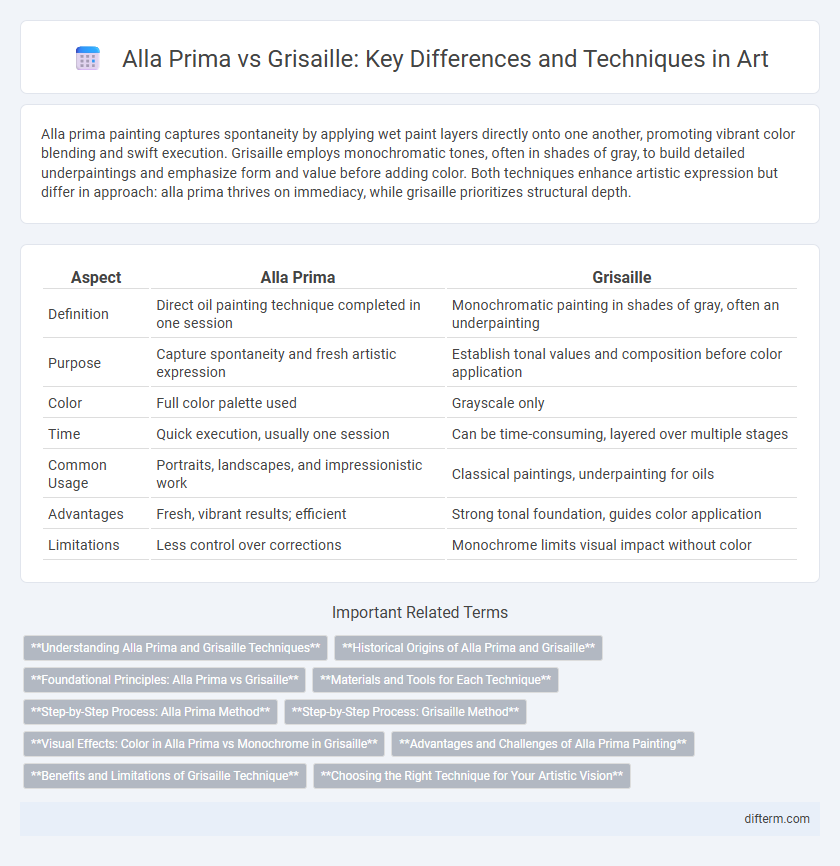Alla prima painting captures spontaneity by applying wet paint layers directly onto one another, promoting vibrant color blending and swift execution. Grisaille employs monochromatic tones, often in shades of gray, to build detailed underpaintings and emphasize form and value before adding color. Both techniques enhance artistic expression but differ in approach: alla prima thrives on immediacy, while grisaille prioritizes structural depth.
Table of Comparison
| Aspect | Alla Prima | Grisaille |
|---|---|---|
| Definition | Direct oil painting technique completed in one session | Monochromatic painting in shades of gray, often an underpainting |
| Purpose | Capture spontaneity and fresh artistic expression | Establish tonal values and composition before color application |
| Color | Full color palette used | Grayscale only |
| Time | Quick execution, usually one session | Can be time-consuming, layered over multiple stages |
| Common Usage | Portraits, landscapes, and impressionistic work | Classical paintings, underpainting for oils |
| Advantages | Fresh, vibrant results; efficient | Strong tonal foundation, guides color application |
| Limitations | Less control over corrections | Monochrome limits visual impact without color |
Understanding Alla Prima and Grisaille Techniques
Alla prima and grisaille are distinct painting techniques that offer unique advantages for artists. Alla prima, or wet-on-wet, involves applying layers of wet paint directly onto previously applied wet paint, enabling rapid completion with vibrant, fresh colors. Grisaille uses monochromatic shades of gray or another neutral tone to create detailed underpaintings or stand-alone works, emphasizing tonal values and form before adding color or remaining monochrome for dramatic effect.
Historical Origins of Alla Prima and Grisaille
Alla prima painting traces its origins to the Renaissance period, prominently used by masters like Titian and Rembrandt for completing works in a single session, emphasizing spontaneity and directness. Grisaille, rooted in medieval and early Renaissance art, was initially employed to simulate sculpture through monochromatic shades of gray, often seen in illuminated manuscripts and stained glass. These distinct historical backgrounds highlight alla prima's focus on immediacy and color, while grisaille centers on form and tonal gradation.
Foundational Principles: Alla Prima vs Grisaille
Alla prima painting emphasizes direct application of wet paint layers, capturing spontaneity and vibrant color in a single session, which supports expressive brushwork and rapid completion. Grisaille relies on monochromatic underpainting, typically in shades of gray, to establish tonal values and composition before adding color, providing a structured foundation for complex layering and detail. The foundational principles contrast immediacy and color confidence in alla prima with gradual tonal development and careful planning inherent in grisaille techniques.
Materials and Tools for Each Technique
Alla prima painting primarily uses oil paints applied wet-on-wet directly onto a primed canvas or panel, with brushes ranging from stiff hog bristle to soft sable for blending. Grisaille technique relies on monochromatic oil or acrylic paints, often in shades of gray, applied on a smooth, rigid surface like a wood panel, with fine brushes and occasionally palette knives to build tonal values. Supports for grisaille must be well-prepared with inert grounds such as gesso to ensure precise value control, contrasting with alla prima's more flexible canvas preparation.
Step-by-Step Process: Alla Prima Method
The Alla Prima method involves painting directly onto the canvas with wet paint in a single session, emphasizing swift brushwork and blending to capture light and color accurately. Artists start with a loose sketch, then block in large color areas, progressively refining details without waiting for layers to dry. This technique requires confidence and spontaneity, allowing for a vibrant, fresh finish distinct from the layered Grisaille approach.
Step-by-Step Process: Grisaille Method
The grisaille method involves creating a monochromatic underpainting in shades of gray to establish tonal values and composition before adding color layers. Artists begin by sketching the basic forms, followed by building up midtones, highlights, and shadows to develop depth and volume. This step-by-step approach allows precise control over lighting and contrast, enhancing the final painting's dimensionality.
Visual Effects: Color in Alla Prima vs Monochrome in Grisaille
Alla prima painting showcases vibrant, direct application of colors that create lively, dynamic visual effects with immediate depth and richness, emphasizing real-time blending of hues on the canvas. Grisaille, characterized by its monochrome palette, employs shades of gray to focus on tonal values and form, producing a sculptural, three-dimensional effect through contrasts of light and shadow. The color intensity in alla prima enhances emotional impact and realism, while grisaille's restrained grayscale palette underscores structure and spatial relationships.
Advantages and Challenges of Alla Prima Painting
Alla prima painting offers the advantage of capturing spontaneous expression and vibrant color by completing a work in a single session, which enhances freshness and emotional immediacy. The technique demands confident brushwork and effective wet-on-wet blending skills, presenting challenges for artists to maintain control and avoid muddy colors. Managing drying times and working quickly without overworking the paint can be difficult but results in dynamic, lively compositions.
Benefits and Limitations of Grisaille Technique
Grisaille technique offers precise control over tonal values, enabling artists to establish strong compositional foundations and depth without the distraction of color. Its monochromatic palette simplifies the painting process and serves as an effective underpainting for subsequent layers, promoting consistency and luminosity. However, the limitation of grisaille lies in its inability to convey the vibrancy and emotional impact of full-color compositions, potentially restricting expressive potential in finished artworks.
Choosing the Right Technique for Your Artistic Vision
Selecting between alla prima and grisaille techniques depends on your desired artistic outcome and workflow. Alla prima offers vibrant, immediate color application ideal for capturing spontaneity and emotion in a single session, while grisaille emphasizes tonal underpainting, enhancing depth and detail before layering colors. Understanding the expressive qualities and procedural differences of each method helps artists align technique with their creative vision and project goals.
alla prima vs grisaille Infographic

 difterm.com
difterm.com